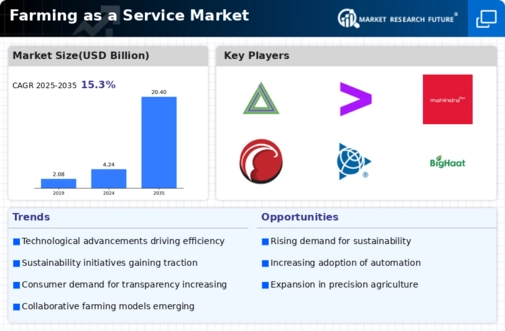Market Growth Projections
The Global Farming as a Service Market Industry is poised for substantial growth, with projections indicating a rise from 4.24 USD Billion in 2024 to 20.4 USD Billion by 2035. This growth trajectory suggests a compound annual growth rate of 15.36% from 2025 to 2035. Such figures highlight the increasing adoption of Farming as a Service models across various regions, driven by technological advancements and changing consumer preferences. The market's expansion reflects a broader trend towards integrating technology into agriculture, which is expected to reshape the industry landscape in the coming years.
Government Support and Policy Initiatives
Government support and policy initiatives are crucial drivers of the Global Farming as a Service Market Industry. Many governments are implementing policies that promote sustainable farming practices and the adoption of innovative technologies. Subsidies for precision agriculture tools and funding for research into sustainable farming methods are examples of such initiatives. These policies not only incentivize farmers to adopt new practices but also create a favorable environment for the growth of Farming as a Service models. As governments recognize the importance of food security and environmental sustainability, their support is likely to bolster market expansion in the years ahead.
Growing Global Population and Food Demand
The Global Farming as a Service Market Industry is significantly influenced by the increasing global population and the corresponding rise in food demand. As the world population continues to grow, projected to reach approximately 9.7 billion by 2050, the pressure on agricultural systems intensifies. This necessitates the adoption of more efficient farming practices to meet food production needs. Farming as a Service models offer scalable solutions that can help farmers increase productivity while managing resources effectively. The urgency to enhance food security is likely to propel the market forward, aligning with the projected growth trajectory.
Rising Demand for Sustainable Agriculture
The Global Farming as a Service Market Industry is experiencing a notable shift towards sustainable agricultural practices. As consumers increasingly prioritize environmentally friendly products, farmers are compelled to adopt methods that reduce their ecological footprint. This trend is reflected in the growing adoption of precision farming technologies, which enhance resource efficiency. For instance, the integration of data analytics and IoT devices allows farmers to optimize water usage and minimize chemical inputs. This shift is projected to drive the market's growth, contributing to an estimated value of 4.24 USD Billion in 2024, with expectations of reaching 20.4 USD Billion by 2035.
Technological Advancements in Agriculture
Technological innovation plays a pivotal role in the Global Farming as a Service Market Industry. The emergence of advanced agricultural technologies, such as drones, robotics, and artificial intelligence, is revolutionizing farming practices. These technologies enable farmers to monitor crop health, automate labor-intensive tasks, and enhance yield predictions. For example, the use of drones for aerial imaging allows for precise assessments of crop conditions, leading to better decision-making. As these technologies become more accessible, they are likely to drive market growth, with a projected compound annual growth rate of 15.36% from 2025 to 2035.
Increasing Investment in Agricultural Startups
The Global Farming as a Service Market Industry is witnessing a surge in investment directed towards agricultural startups. Venture capitalists and government initiatives are increasingly funding innovative solutions that address challenges in food production and distribution. This influx of capital is fostering the development of new technologies and services that enhance farming efficiency. For instance, startups focusing on vertical farming and hydroponics are gaining traction, as they offer solutions to urban food production challenges. This trend not only stimulates market growth but also encourages the adoption of Farming as a Service models, which are expected to flourish in the coming years.









Leave a Comment